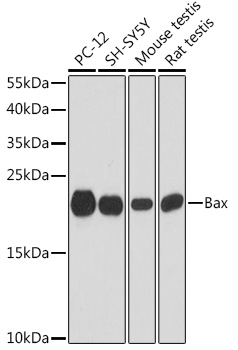| Background: | The protein encoded by this gene belongs to the BCL2 protein family. BCL2 family members form hetero- or homodimers and act as anti- or pro-apoptotic regulators that are involved in a wide variety of cellular activities. This protein forms a heterodimer with BCL2, and functions as an apoptotic activator. This protein is reported to interact with, and increase the opening of, the mitochondrial voltage-dependent anion channel (VDAC), which leads to the loss in membrane potential and the release of cytochrome c. The expression of this gene is regulated by the tumor suppressor P53 and has been shown to be involved in P53-mediated apoptosis. Multiple alternatively spliced transcript variants, which encode different isoforms, have been reported for this gene. |
| UniProt Protein Function: | Accelerates programmed cell death by binding to, and antagonizing the apoptosis repressor BCL2 or its adenovirus homolog E1B 19k protein. Under stress conditions, undergoes a conformation change that causes translocation to the mitochondrion membrane, leading to the release of cytochrome c that then triggers apoptosis. Promotes activation of CASP3, and thereby apoptosis. |
| NCBI Summary: | The protein encoded by this gene belongs to the BCL2 protein family. BCL2 family members form hetero- or homodimers and act as anti- or pro-apoptotic regulators that are involved in a wide variety of cellular activities. This protein forms a heterodimer with BCL2, and functions as an apoptotic activator. This protein is reported to interact with, and increase the opening of, the mitochondrial voltage-dependent anion channel (VDAC), which leads to the loss in membrane potential and the release of cytochrome c. The expression of this gene is regulated by the tumor suppressor P53 and has been shown to be involved in P53-mediated apoptosis. Multiple alternatively spliced transcript variants, which encode different isoforms, have been reported for this gene. [provided by RefSeq, Jul 2008] |
| UniProt Code: | Q07812 |
| NCBI GenInfo Identifier: | 728945 |
| NCBI Gene ID: | 581 |
| NCBI Accession: | Q07812.1 |
| UniProt Secondary Accession: | Q07812,P55269, Q07814, Q07815, Q8WZ49, Q9NR76, Q9NYG7 Q9UCZ6, Q9UCZ7, Q9UQD6, A8K4W1, |
| UniProt Related Accession: | Q07812 |
| Molecular Weight: | 19,718 Da |
| NCBI Full Name: | Apoptosis regulator BAX |
| NCBI Synonym Full Names: | BCL2 associated X, apoptosis regulator |
| NCBI Official Symbol: | BAX |
| NCBI Official Synonym Symbols: | BCL2L4 |
| NCBI Protein Information: | apoptosis regulator BAX |
| UniProt Protein Name: | Apoptosis regulator BAX |
| UniProt Synonym Protein Names: | Bcl-2-like protein 4; Bcl2-L-4 |
| Protein Family: | Protein |
| UniProt Gene Name: | BAX |
| UniProt Entry Name: | BAX_HUMAN |








![Anti-Bax Antibody [KO Validated] (CAB19684) Anti-Bax Antibody [KO Validated] (CAB19684)](https://cdn11.bigcommerce.com/s-rd6ounxcu2/images/stencil/590x590/products/55995/61177/anti-bax-antibody-ko-validated-cab19684__69640__02007.1706533730.jpg?c=1)
![Anti-Bax Antibody (CAB12009)[KO Validated] Anti-Bax Antibody (CAB12009)[KO Validated]](https://cdn11.bigcommerce.com/s-rd6ounxcu2/images/stencil/590x590/products/39438/44184/anti-bax-antibody-cab12009ko-validated__29370__19510.1706521332.jpg?c=1)
![Anti-Bax Antibody (CAB11550)[KO Validated] Anti-Bax Antibody (CAB11550)[KO Validated]](https://cdn11.bigcommerce.com/s-rd6ounxcu2/images/stencil/590x590/products/39214/43960/anti-bax-antibody-cab11550ko-validated__13164__14517.1706521249.jpg?c=1)
![Anti-Bax Antibody (CAB15633)[KO Validated] Anti-Bax Antibody (CAB15633)[KO Validated]](https://cdn11.bigcommerce.com/s-rd6ounxcu2/images/stencil/590x590/products/42938/47683/anti-bax-antibody-cab15633ko-validated__49898__17284.1706523088.jpg?c=1)